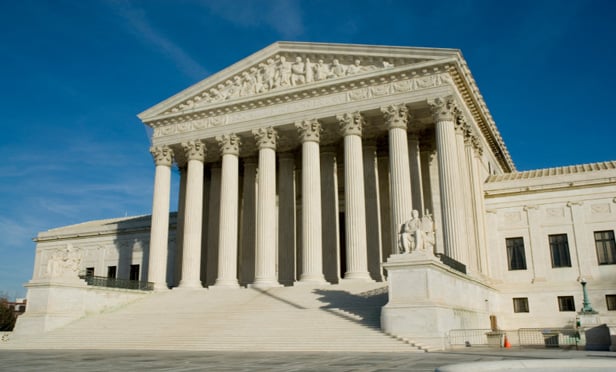Features

The Increasing Challenges of Verification on Social Media
The recent flurry of online impersonators, ranging from accounts posing as President Joe Biden to the pharmaceutical company Eli Lilly, exposes the challenges of social media platforms' verification and authentication processes. These events show that monitoring and policing trademark infringements and right of publicity violations can be increasingly difficult in the social media context.
Features

Successful Hybrid Plans Offer 'Best of Both Worlds'
We're seeing is a variety of successful measures that are designed to help attorneys get what they want: a best-of-both worlds scenario where they keep some work-from-home and fold-in an opportunity to intentionally connect and collaborate with colleagues in the office.
Features

The Future of AI Is More Ironman than Terminator
Many fear cyborgs stealing corner offices from rainmakers, that the future will be Robolawyers instead of humans. The reality is that the most powerful AI today, when applied to complex areas like legal, is more reliant on human interaction, not less.
Features

U.S. Supreme Court Will Hear Political Football Section 230 Case — Why This One?
The Supreme Court has decided in the context of national security to consider the parameters of, and possible limits to, "Section 230" liability protections for social media companies. The question is why this case? The Supreme Court has decided to accept a case that, while sounding narrow and technical, actually goes to the heart of the way many Internet platforms operate — algorithmic targeted content recommendations.
Features

Legal Tech: The Attorney-Client Privilege Purpose Requirement and E-Discovery
On Jan. 9, the U.S. Supreme Court heard oral argument on whether the attorney-client privilege protects against disclosure of dual-purpose communications — where the communications contain both legal and nonlegal advice.
Features

Regulators Reaching Deep In Their Toolbox to Prosecute Users of Encrypted Messages
If you use Whatsapp or similar platforms for work-related communications, then you've probably heard that regulators are putting an end to that practice. Ephemeral and encrypted messaging, they have noted, evades monitoring and prevents retention. A seldom used doctrine allows prosecutors to charge executives with misdemeanor offenses just for being in the position of power when others commit the misconduct. Rather than take a wait-and-see approach, companies and their leaders would do well to prepare for prosecutors to reach deep into their toolbox.
Features

Typically Uncommon: Defending Class Action Certification in Data Breach Litigation
The most common questions and key elements of a negligence claim are whether the defendant breached a duty of care, whether there is any injury as a result of the defendant's breach of any purported duty of care, and whether the defendant's alleged breach caused the plaintiff any damages. While these essential questions and elements apply with equal force in data breach litigation, the difficult question to answer in these cases is "what is the value, if any, of your injury or damages?"
Features

A Legal CIO's Guide to Technology Procurement In 2023
For a legal CIO, one of the key responsibilities is to establish that the organization has the right technology in place to support its operations and achieve its business goals. This can be challenging, as there are many factors to consider when choosing new technology for your organization. One bad decision can have a material impact on not only the bottom line, but on the ability of your firm to compete in an ever-changing legal market.
Features

Best Practices In Second Request Document Review: Eliminating the Fear Factor
Part One of a Two-Part Article: Challenges and solutions in document review HSR second requests have become increasingly common in mergers or acquisitions that meet the premerger reporting threshold, which in 2022 was a transaction value of more than $101 million. The burdens of complying with second requests are onerous. The mere thought of undergoing such an exercise tends to strike fear in the heart of the legal department. In this article series, we'll outline the major challenges of second requests, suggest strategies to overcome them, and discuss how to face a second request with equanimity and confidence.
Features

The NFT Market and Fallout from the FTX Scandal
The FTX bankruptcy scandal that has shaken the largely unregulated cryptocurrency world has slowed but isn't likely to end the roll-out of celebrity-related, non-fungible digital token (NFT) offerings. But how might the FTX story impact a push for federal regulation of the NFT market?
Need Help?
- Prefer an IP authenticated environment? Request a transition or call 800-756-8993.
- Need other assistance? email Customer Service or call 1-877-256-2472.
MOST POPULAR STORIES
- The DOJ's Corporate Enforcement Policy: One Year LaterThe DOJ's Criminal Division issued three declinations since the issuance of the revised CEP a year ago. Review of these cases gives insight into DOJ's implementation of the new policy in practice.Read More ›
- The DOJ's New Parameters for Evaluating Corporate Compliance ProgramsThe parameters set forth in the DOJ's memorandum have implications not only for the government's evaluation of compliance programs in the context of criminal charging decisions, but also for how defense counsel structure their conference-room advocacy seeking declinations or lesser sanctions in both criminal and civil investigations.Read More ›
- How to TOOT Your Own Horn: Exceptional Self EvaluationsIt's that time again. As the year comes to a close many firms are beginning the associate review process. Even if your firm does not have a formal review process I recommend that you write a self-evaluation that outlines your achievements and specifies your goals for the coming year.Read More ›
- The FTC Gets Into the College Athlete NIL GameAs national champions are crowned in men's and women's basketball, hundreds of thousands of college athletes are entering the influencer marketplace for the first time and now find themselves attractive candidates in the fast growing influencer marketing arena. With influencer marketing potentially providing a 5x return on investment, many brands are eager to get into the industry, but it doesn't come without risks as the FTC Commissioner is taking a closer look at the use of influencers for marketing.Read More ›
- Use of Deferred Prosecution Agreements In White Collar InvestigationsThis article discusses the practical and policy reasons for the use of DPAs and NPAs in white-collar criminal investigations, and considers the NDAA's new reporting provision and its relationship with other efforts to enhance transparency in DOJ decision-making.Read More ›
